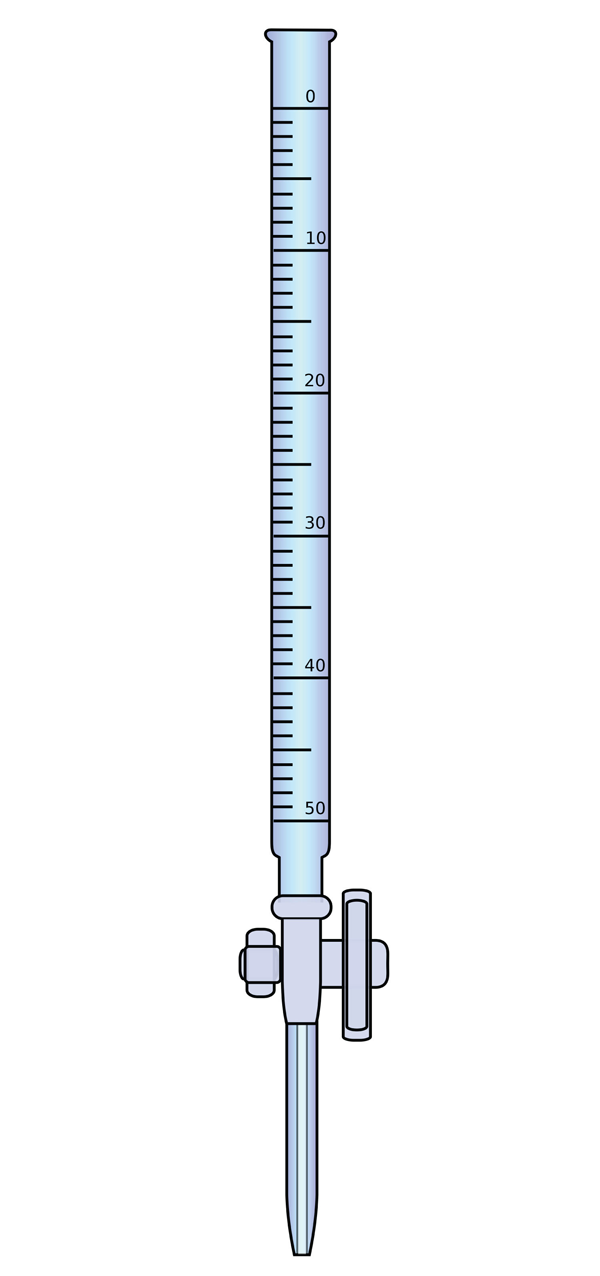72 Acid-Base Titrations
[latexpage]
Learning Objectives
- Describe a titration experiment.
- Explain what an indicator does.
- Perform a titration calculation correctly.
The reaction of an acid with a base to make a salt and water is a common reaction in the laboratory, partly because so many compounds can act as acids or bases. Another reason that acid-base reactions are so prevalent is because they are often used to determine quantitative amounts of one or the other. Performing chemical reactions quantitatively to determine the exact amount of a reagent is called a titration. A titration can be performed with almost any chemical reaction for which the balanced chemical equation is known. Here, we will consider titrations that involve acid-base reactions.
In a titration, one reagent has a known concentration or amount, while the other reagent has an unknown concentration or amount. Typically, the known reagent (the titrant) is added to the unknown quantity and is dissolved in solution. The unknown amount of substance (the analyte) may or may not be dissolved in solution (but usually is). The titrant is added to the analyte using a precisely calibrated volumetric delivery tube called a burette (also spelled buret; see Figure 12.1 "Equipment for Titrations"). The burette has markings to determine how much volume of solution has been added to the analyte. When the reaction is complete, it is said to be at the equivalence point; the number of moles of titrant can be calculated from the concentration and the volume, and the balanced chemical equation can be used to determine the number of moles (and then concentration or mass) of the unknown reactant.

For example, suppose 25.66 mL (or 0.02566 L) of 0.1078 M HCl was used to titrate an unknown sample of NaOH. What mass of NaOH was in the sample? We can calculate the number of moles of HCl reacted:
[latex]\#\text{ mol HCl}=(0.02566\text{ L})(0.1078\text{ M})=0.002766\text{ mol HCl}[/latex]
We also have the balanced chemical reaction between HCl and NaOH:
HCl + NaOH → NaCl + H2O
So we can construct a conversion factor to convert to number of moles of NaOH reacted:
[latex]0.002766\text{ \cancel{mol HCl}}\times\dfrac{1\text{ mol NaOH}}{1\text{ \cancel{mol HCl}}}=0.002766\text{ mol NaOH}[/latex]
Then we convert this amount to mass, using the molar mass of NaOH (40.00 g/mol):
[latex]0.002766\text{ \cancel{mol NaOH}}\times\dfrac{40.00\text{ g NaOH}}{1\text{ \cancel{mol NaOH}}}=0.1106\text{ g NaOH}[/latex]
This is type of calculation is performed as part of a titration.
Example 12.1
What mass of Ca(OH)2 is present in a sample if it is titrated to its equivalence point with 44.02 mL of 0.0885 M HNO3? The balanced chemical equation is as follows:
2HNO3 + Ca(OH)2 → Ca(NO3)2 + 2H2O
Solution
In litres, the volume is 0.04402 L. We calculate the number of moles of titrant:
[latex]\#\text{ moles }\ce{HNO3}=(0.04402\text{ L})(0.0885\text{ M})=0.00390\text{ mol }\ce{HNO3}[/latex]
Using the balanced chemical equation, we can determine the number of moles of Ca(OH)2 present in the analyte:
[latex]0.00390\cancel{\text{ mol }\ce{HNO3}}\times\dfrac{1\text{ mol }\ce{Ca(OH)2}}{2\cancel{\text{ mol }\ce{HNO3}}}=0.00195\text{ mol }\ce{Ca(OH)2}[/latex]
Then we convert this to a mass using the molar mass of Ca(OH)2:
[latex]0.00195\cancel{\text{ mol }\ce{Ca(OH)2}}\times \dfrac{74.1\text{ g }\ce{Ca(OH)2}}{1\cancel{\text{ mol }\ce{Ca(OH)2}}}=0.144\text{ g }\ce{Ca(OH)2}[/latex]
Test Yourself
What mass of H2C2O4 is present in a sample if it is titrated to its equivalence point with 18.09 mL of 0.2235 M NaOH? The balanced chemical reaction is as follows:
H2C2O4 + 2NaOH → Na2C2O4 + 2H2O
Answer
0.182 g
How does one know if a reaction is at its equivalence point? Usually, the person performing the titration adds a small amount of an indicator, a substance that changes colour depending on the acidity or basicity of the solution. Because different indicators change colours at different levels of acidity, choosing the correct one is important in performing an accurate titration.
For more information, watch this video: "Titration" by Jessie Key.
Key Takeaways
- A titration is the quantitative reaction of an acid and a base.
- Indicators are used to show that all the analyte has reacted with the titrant.
Exercises
Questions
- Define titration.
- What is the difference between the titrant and the analyte?
- True or false: An acid is always the titrant. Explain your answer.
- True or false: An analyte is always dissolved before reaction. Explain your answer.
- If 55.60 mL of 0.2221 M HCl was needed to titrate a sample of NaOH to its equivalence point, what mass of NaOH was present?
- If 16.33 mL of 0.6664 M KOH was needed to titrate a sample of HC2H3O2 to its equivalence point, what mass of HC2H3O2 was present?
- It takes 45.66 mL of 0.1126 M HBr to titrate 25.00 mL of Ca(OH)2 to its equivalence point. What is the original concentration of the Ca(OH)2 solution?
- It takes 9.77 mL of 0.883 M H2SO4 to titrate 15.00 mL of KOH to its equivalence point. What is the original concentration of the KOH solution?
Answers
- A chemical reaction performed in a quantitative fashion.
- False; a base can be a titrant, or the reaction being performed may not even be an acid-base reaction.
- 0.494 g
- 0.1028 M

